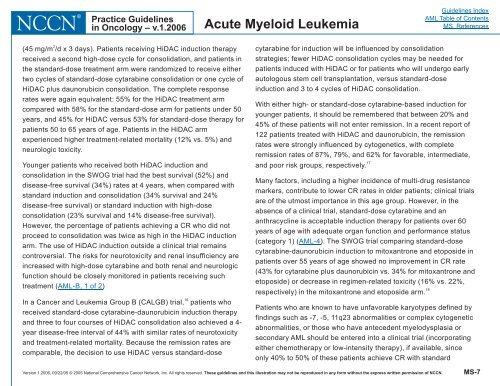Acute Myeloid Leukemia
Acute Myeloid Leukemia
Acute Myeloid Leukemia
You also want an ePaper? Increase the reach of your titles
YUMPU automatically turns print PDFs into web optimized ePapers that Google loves.
®<br />
NCCN<br />
Practice Guidelines<br />
in Oncology – v.1.2006<br />
<strong>Acute</strong> <strong>Myeloid</strong> <strong>Leukemia</strong><br />
Guidelines Index<br />
AML Table of Contents<br />
MS, References<br />
2<br />
(45 mg/m /d x 3 days). Patients receiving HiDAC induction therapy<br />
received a second high-dose cycle for consolidation, and patients in<br />
the standard-dose treatment arm were randomized to receive either<br />
two cycles of standard-dose cytarabine consolidation or one cycle of<br />
HiDAC plus daunorubicin consolidation. The complete response<br />
rates were again equivalent: 55% for the HiDAC treatment arm<br />
compared with 58% for the standard-dose arm for patients under 50<br />
years, and 45% for HiDAC versus 53% for standard-dose therapy for<br />
patients 50 to 65 years of age. Patients in the HiDAC arm<br />
experienced higher treatment-related mortality (12% vs. 5%) and<br />
neurologic toxicity.<br />
Younger patients who received both HiDAC induction and<br />
consolidation in the SWOG trial had the best survival (52%) and<br />
disease-free survival (34%) rates at 4 years, when compared with<br />
standard induction and consolidation (34% survival and 24%<br />
disease-free survival) or standard induction with high-dose<br />
consolidation (23% survival and 14% disease-free survival).<br />
However, the percentage of patients achieving a CR who did not<br />
proceed to consolidation was twice as high in the HiDAC induction<br />
arm. The use of HiDAC induction outside a clinical trial remains<br />
controversial. The risks for neurotoxicity and renal insufficiency are<br />
increased with high-dose cytarabine and both renal and neurologic<br />
function should be closely monitored in patients receiving such<br />
treatment ( AML-B, 1 of 2)<br />
In a Cancer and <strong>Leukemia</strong> Group B (CALGB) trial,<br />
patients who<br />
received standard-dose cytarabine-daunorubicin induction therapy<br />
and three to four courses of HiDAC consolidation also achieved a 4-<br />
year disease-free interval of 44% with similar rates of neurotoxicity<br />
and treatment-related mortality. Because the remission rates are<br />
comparable, the decision to use HiDAC versus standard-dose<br />
16<br />
cytarabine for induction will be influenced by consolidation<br />
strategies; fewer HiDAC consolidation cycles may be needed for<br />
patients induced with HiDAC or for patients who will undergo early<br />
autologous stem cell transplantation, versus standard-dose<br />
induction and 3 to 4 cycles of HiDAC consolidation.<br />
With either high- or standard-dose cytarabine-based induction for<br />
younger patients, it should be remembered that between 20% and<br />
45% of these patients will not enter remission. In a recent report of<br />
122 patients treated with HiDAC and daunorubicin, the remission<br />
rates were strongly influenced by cytogenetics, with complete<br />
remission rates of 87%, 79%, and 62% for favorable, intermediate,<br />
and poor risk groups, respectively.<br />
Many factors, including a higher incidence of multi-drug resistance<br />
markers, contribute to lower CR rates in older patients; clinical trials<br />
are of the utmost importance in this age group. However, in the<br />
absence of a clinical trial, standard-dose cytarabine and an<br />
anthracycline is acceptable induction therapy for patients over 60<br />
years of age with adequate organ function and performance status<br />
(category 1) ( AML-4). The SWOG trial comparing standard-dose<br />
cytarabine-daunorubicin induction to mitoxantrone and etoposide in<br />
patients over 55 years of age showed no improvement in CR rate<br />
(43% for cytarabine plus daunorubicin vs. 34% for mitoxantrone and<br />
etoposide) or decrease in regimen-related toxicity (16% vs. 22%,<br />
respectively) in the mitoxantrone and etoposide arm.<br />
Patients who are known to have unfavorable karyotypes defined by<br />
findings such as -7, -5, 11q23 abnormalities or complex cytogenetic<br />
abnormalities, or those who have antecedent myelodysplasia or<br />
secondary AML should be entered into a clinical trial (incorporating<br />
either chemotherapy or low-intensity therapy), if available, since<br />
only 40% to 50% of these patients achieve CR with standard<br />
17<br />
18<br />
Version 1.2006, 09/22/05 © 2005 National Comprehensive Cancer Network, Inc. All rights reserved. These guidelines and this illustration may not be reproduced in any form without the express written permission of NCCN.<br />
MS-7

















